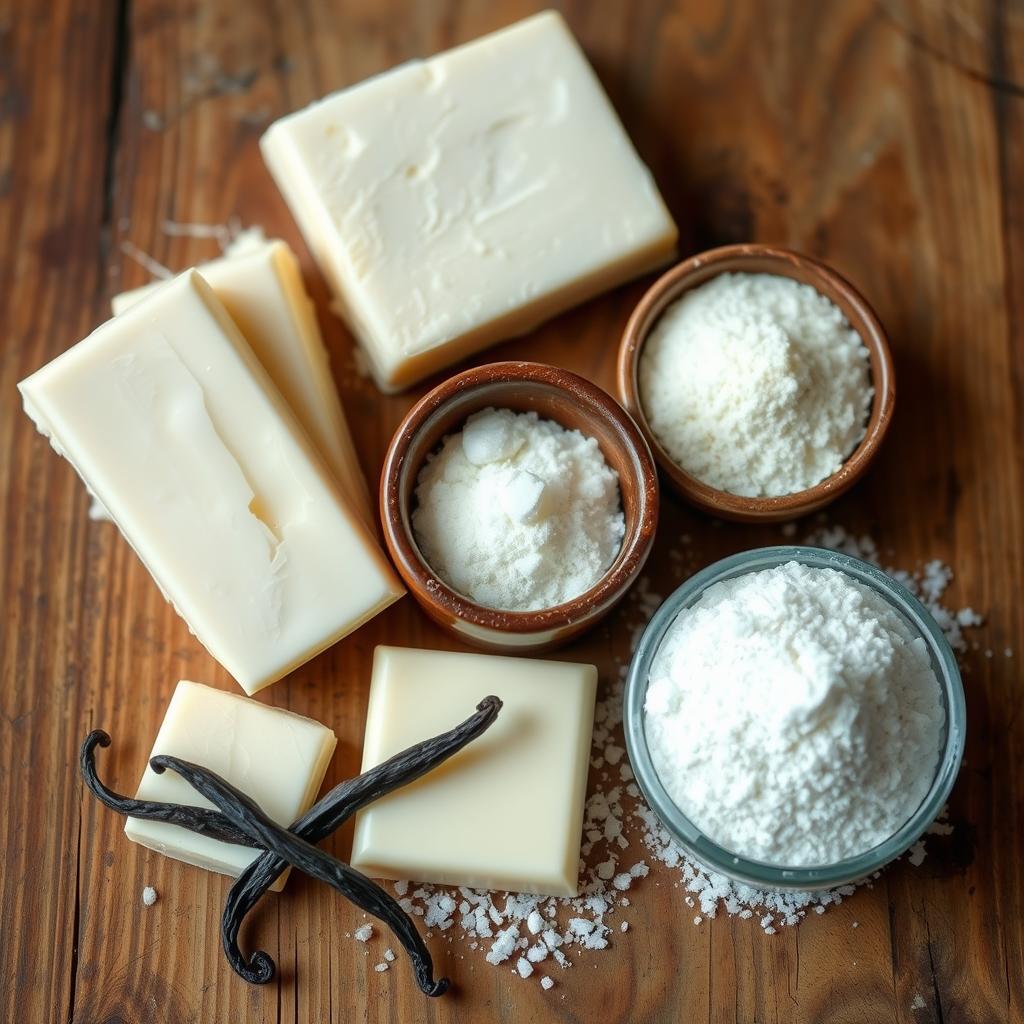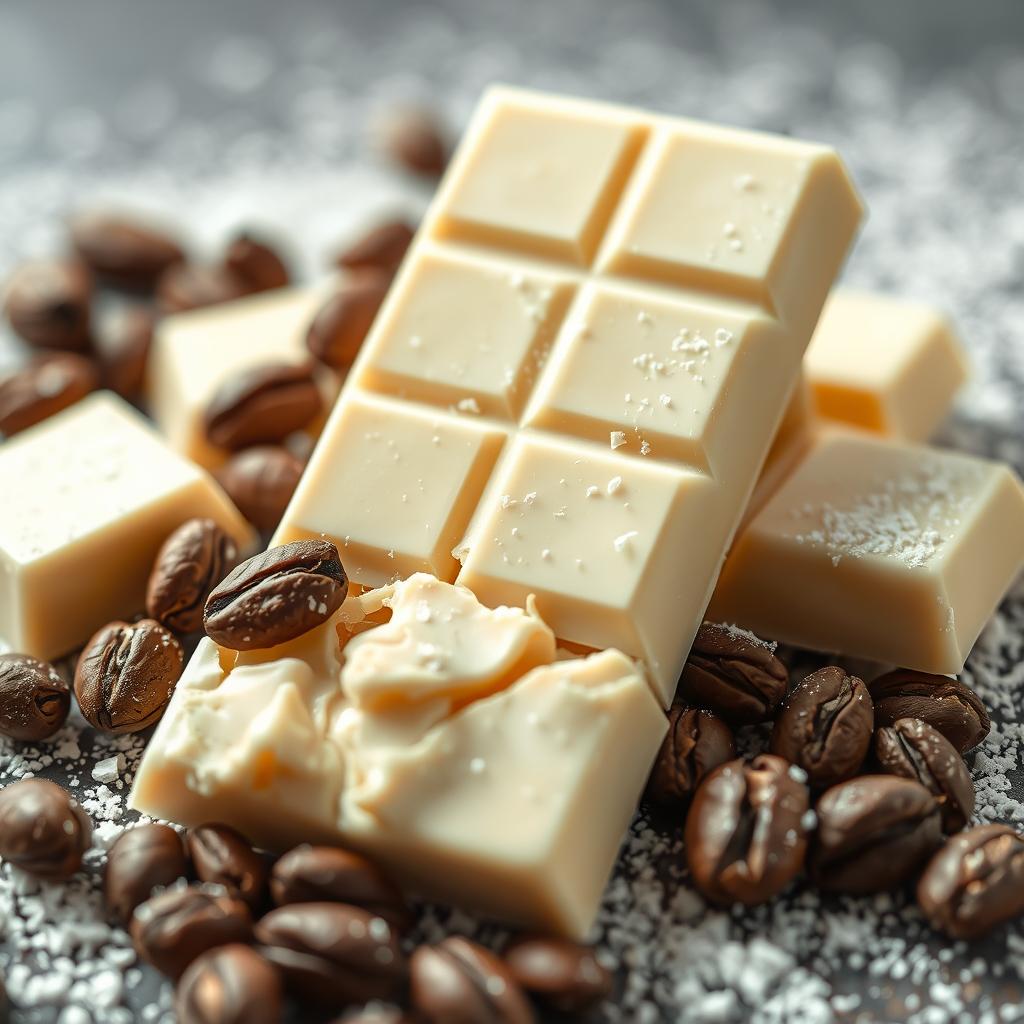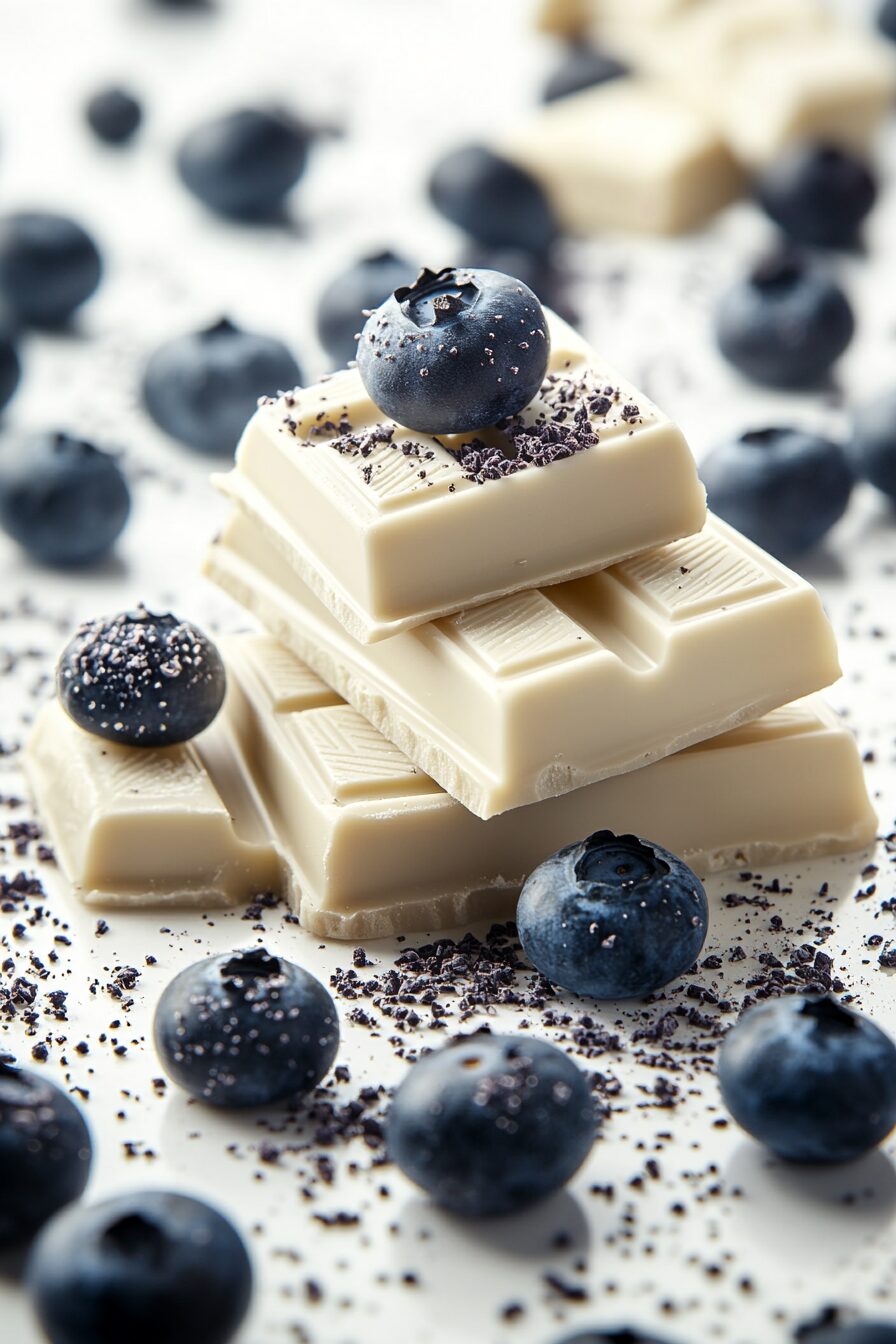Living with gluten sensitivity can be tough, especially when it comes to enjoying chocolates. The joy of white chocolate can turn into a worry about gluten. But, there’s hope. This guide will help you understand if white chocolate is gluten-free and how to choose safe options.
We’ll look into what white chocolate is made of and its gluten-free aspects. You’ll learn about gluten contamination and how to spot gluten-free labels. We’ll also share the best white chocolate brands for those with gluten sensitivities. Plus, we’ll give you tasty gluten-free dessert ideas that feature white chocolate.

Table of Contents
Key Takeaways
- White chocolate is not inherently gluten-free, as it may contain ingredients derived from gluten-containing grains.
- Careful label reading and understanding certifications are crucial to identifying gluten-free white chocolate products.
- Certain white chocolate brands are formulated to be gluten-free, providing safe options for those with gluten sensitivities.
- Gluten-free baking with white chocolate requires attention to cross-contamination risks and carefully selected recipes.
- Consuming high-quality, gluten-free white chocolate can be a delightful and safe indulgence for those with gluten sensitivities.
Understanding White Chocolate: What It Really Is
White chocolate might seem simple, but it’s actually quite unique. It’s different from dark and milk chocolate. Let’s explore what makes up this tasty treat.
The Basic Components of White Chocolate
White chocolate is made of a few main ingredients: cocoa butter, milk solids, and sugar. The cocoa butter gives it a creamy texture. The milk solids add richness and a hint of dairy flavor. Sugar balances out the cocoa butter’s natural bitterness, making it sweet.
How White Chocolate Differs from Dark and Milk Chocolate
White chocolate doesn’t have the chocolatey taste that dark chocolate does. It also doesn’t have cocoa liquor or powder like milk chocolate. This makes white chocolate lighter, creamier, and sweeter than the others.
The way white chocolate is made is different too. While dark and milk chocolate start with cocoa beans, white chocolate uses only cocoa butter. This process gives it a pale color and a sweet taste without any chocolate flavor.

Is White Chocolate Gluten-Free?
Most pure, unadulterated white chocolate is naturally gluten-free. The main ingredients – cocoa butter, milk solids, and sugar – don’t have gluten. This makes white chocolate a good choice for those who follow a gluten-free diet.
But, there are some things that can make white chocolate not gluten-free. Some products might have extra ingredients like flavorings or stabilizers that have gluten. Also, there’s a chance of gluten getting into the chocolate if it’s made in a place that also handles wheat.
| Ingredient | Gluten-Free Status |
|---|---|
| Cocoa Butter | Gluten-Free |
| Milk Solids | Gluten-Free |
| Sugar | Gluten-Free |
| Flavorings | May Contain Gluten |
| Stabilizers | May Contain Gluten |
To make sure white chocolate is gluten-free, always check the labels. Look for any gluten-containing ingredients or warnings about cross-contamination. With some careful checking, you can enjoy gluten-free chocolate without worries.

Key Ingredients in White Chocolate Production
White chocolate is made from a few key ingredients. These include cocoa butter, milk solids, and sugar. Each plays a unique role in making white chocolate special.
Cocoa Butter’s Role
Cocoa butter is at the heart of white chocolate. It’s a creamy substance from cocoa beans. This ingredient makes white chocolate smooth and gives it a unique taste.
Its high-fat content is why white chocolate melts so easily in your mouth.
Milk Solids and Sugar Components
White chocolate also has a lot of milk solids. These come from powdered or condensed milk. They add creaminess and sweetness.
Sugar, usually granulated or powdered, makes white chocolate even sweeter.
Additional Ingredients and Flavorings
Manufacturers may add extra ingredients and flavorings to white chocolate. These can include vanilla extract, lecithin, and even fruit purees or nuts. They help create different flavors.
It’s important to check the label to make sure these extras are gluten-free.
| Ingredient | Function |
|---|---|
| Cocoa Butter | Contributes to the smooth, creamy texture and distinct flavor of white chocolate. |
| Milk Solids | Adds creaminess and sweetness to white chocolate. |
| Sugar | Further enhances the sweet taste of white chocolate. |
| Vanilla Extract | Provides a classic vanilla flavor profile. |
| Lecithin | Acts as an emulsifier to maintain the smooth, consistent texture. |
| Fruit Purees or Nuts | Can be added to create unique flavor variations. |
Common Sources of Gluten Contamination in White Chocolate
As someone who cares about their health, it’s important to know where gluten might hide in white chocolate. White chocolate itself is naturally gluten-free. But, the way it’s made and the ingredients added can bring gluten into the mix. Let’s look at the common issues to watch out for when picking gluten-free chocolate.
Shared Equipment and Cross-Contamination
One big worry with white chocolate is cross-contamination. Many chocolate makers use the same equipment for all their products. This can accidentally mix gluten from other foods into the gluten-free chocolate.
Flavorings and Inclusions
White chocolate also gets extra flavor from things like nuts, caramel, or fruit. Sometimes, these extras might have gluten in them. This is a problem for people with a white chocolate allergy or gluten issues.
- Nut-based fillings or coatings may be processed on shared equipment, leading to cross-contamination.
- Caramel sauces and other flavor additives may incorporate wheat-derived thickeners or stabilizers.
- Certain fruit-flavored white chocolate products may contain gluten-containing ingredients, such as graham cracker crumbs or cookie pieces.
Always check the ingredients and what the maker says to make sure the white chocolate is gluten-free.
Knowing where gluten might sneak into white chocolate helps you make better choices. You can enjoy white chocolate without worrying about your diet.
Reading White Chocolate Labels for Gluten Content
Finding gluten-free chocolate can be tough, especially with white chocolate brands. But, by understanding label info, you can spot safe white chocolate for those with gluten issues.
Understanding Certification Labels
First, check for gluten-free logos on white chocolate labels. Seals like the Gluten-Free Certification Organization (GFCO) or the Celiac Support Association show the product meets gluten-free standards. It means the product has less than 20 parts per million (ppm) of gluten.
Hidden Gluten Terms to Watch For
- Malt: This ingredient, often found in white chocolate flavored with vanilla, is typically derived from barley, a gluten-containing grain.
- Wheat-based ingredients: Terms like “flour,” “starch,” or “modified food starch” may signal the presence of gluten in the white chocolate formula.
- Barley-based ingredients: Look out for ingredients like “malt extract” or “malted barley flour,” which are clear indicators of gluten.
By carefully checking white chocolate labels, you can enjoy tasty treats that are also safe for your diet.
Popular White Chocolate Brands That Are Gluten-Free
If you love white chocolate and need it to be gluten-free, you’re in luck. Many top brands offer gluten-free white chocolate. They make sure their products are safe for those with gluten sensitivities.
Ghirardelli is a well-known brand in the chocolate world. Their white chocolate products, like Classic White Chips and Bars, are gluten-free. This makes them a great choice for those with gluten issues.
Lindt also has a range of gluten-free white chocolate options. Their Classic White Chocolate, White Chocolate Truffles, and White Chocolate Bars are all gluten-free. This gives consumers peace of mind.
Guittard is another respected brand that caters to gluten-free needs. Their white chocolate products, like Organic White Chocolate Chips and Baking Wafers, are gluten-free. They’re perfect for baking and desserts.
| Brand | Gluten-Free White Chocolate Products | Gluten-Free Certification |
|---|---|---|
| Ghirardelli | Classic White Chips, White Chocolate Bars | Certified Gluten-Free |
| Lindt | Classic White Chocolate, White Chocolate Truffles, White Chocolate Bars | Certified Gluten-Free |
| Guittard | Organic White Chocolate Chips, Baking Wafers | Certified Gluten-Free |
When buying white chocolate, always check for the gluten-free logo. Or read the labels carefully. This ensures the white chocolate meets your dietary needs.
Cross-Contamination Risks in White Chocolate Manufacturing
Ensuring Pale chocolate is gluten-free is crucial. Manufacturers must avoid cross-contamination to keep it safe for those with Pale chocolate allergy or gluten-free chocolate sensitivity.
Shared Equipment Concerns
Shared equipment is a big risk in white chocolate making. Many products, including gluten-containing ones, are made on the same machines. It’s vital to clean and sanitize well to avoid gluten transfer to white chocolate.
Factory Processing Standards
- Strict segregation of production lines for gluten-containing and gluten-free products
- Rigorous cleaning and sanitization procedures between production runs
- Dedicated storage and packaging areas for gluten-free white chocolate
- Regular testing and verification of gluten levels in the final products
High-quality manufacturing standards help reduce cross-contamination risks. This ensures white chocolate is safe for those with gluten sensitivities or allergies.
| Potential Allergen | Source | Mitigation Strategies |
|---|---|---|
| Gluten | Shared equipment, processing lines, and storage facilities | Strict segregation, thorough cleaning, dedicated gluten-free areas |
| Milk proteins | Milk solids and dairy ingredients in white chocolate | Careful ingredient sourcing, thorough testing, clear labeling |
| Flavorings and additives | Ingredients used to enhance the taste and texture of white chocolate | Scrutinize supplier documentation, conduct in-house testing |
Knowing the risks and what manufacturers do helps those with dietary restrictions. It lets them decide if Pale chocolate and gluten-free chocolate are right for them.
White Chocolate Alternatives for Gluten-Sensitive Individuals
If you’re gluten-sensitive, there’s good news. Many dairy-free and vegan white chocolate options are now available. These products meet different dietary needs and offer the creamy texture and rich flavor of traditional white chocolate.
Dairy-free white chocolate uses plant-based ingredients like coconut, cashews, or almonds instead of dairy. It’s smooth and rich, without gluten or lactose. Vegan white chocolate is made from cocoa butter, plant-based milks, and sweeteners like cane sugar or maple syrup.
| Product | Gluten-Free | Dairy-Free | Vegan |
|---|---|---|---|
| Enjoy Life Baking Chips | ✓ | ✓ | ✓ |
| Pascha White Chocolate Chips | ✓ | ✓ | ✓ |
| Nutiva Organic Shortening | ✓ | ✓ | ✓ |
When looking for gluten-free white chocolate, always check the labels. Look for certifications and make sure there’s no hidden gluten. With a little research, you can enjoy creamy white chocolate that fits your dietary needs.
“The best part about these dairy-free and vegan white chocolate options is that they don’t sacrifice flavor or texture. I can enjoy all the richness without worrying about gluten or dairy.”
Making Gluten-Free Desserts with Pale chocolate
If you’re gluten-sensitive, white chocolate can be a tasty treat. It’s rich and creamy. There are safe baking tips and recipe changes to make gluten-free desserts with Pale chocolate.
Safe Baking Tips
- Always choose a gluten-free certified Pale chocolate brand to ensure no cross-contamination with wheat-based products.
- Carefully read ingredient labels to avoid any hidden sources of gluten, such as emulsifiers or flavorings.
- Use dedicated baking utensils, pans, and surfaces to prevent gluten transfer from other recipes.
- Consider substituting white chocolate chips or chunks for recipes that call for traditional chocolate chips.
Recipe Modifications
Changing classic desserts to be gluten-free with gluten-free chocolate is easy. Here are some tips:
- Replace wheat-based flour with gluten-free flour blends in cakes, cookies, and bars.
- Swap graham crackers or cookie crusts for gluten-free ones in cheesecakes and pies.
- Try almond flour, coconut flour, or white chocolate nutrition-boosting nut butters as binders.
- Add gluten-free chocolate chips or chunks to muffins, scones, and other baked goods.
With a bit of experimentation and careful attention, you can make delicious gluten-free desserts. They’ll feature the creamy, indulgent flavor of gluten-free chocolate.
| Ingredient | Gluten-Free Substitute |
|---|---|
| All-purpose flour | Gluten-free flour blend |
| Graham crackers | Gluten-free graham crackers |
| Cookie crumbs | Gluten-free cookie crumbs |
| Breadcrumbs | Gluten-free breadcrumbs |
Health Considerations When Consuming White Chocolate
White chocolate is a special kind of chocolate that we should think about its health effects. It has its own nutritional values that can affect our health. Let’s look at the important things to remember when enjoying this creamy treat.
The first thing to think about is the white chocolate nutrition. White chocolate has less cocoa than dark chocolate but can still have a lot of sugar and fat. Eating too much white chocolate can lead to weight gain and high blood sugar, especially for people with diabetes.
It’s also important to consider the risk of white chocolate allergy. Some people might be allergic to milk proteins or soy in white chocolate. Always check the labels for any allergies and be careful before eating white chocolate products.
“Moderation is key when it comes to enjoying white chocolate. Savor it in small portions and be mindful of any personal health concerns.”
In short, white chocolate can be a tasty treat but we need to be careful. Knowing about the white chocolate nutrition and any allergies we might have helps us enjoy it safely. This way, we can enjoy this special chocolate while taking care of our health.
Conclusion
The gluten-free status of white chocolate depends on its ingredients and how it’s made. Many white chocolate brands are gluten-free. But, always check the labels and look for certified gluten-free options to stay safe.
When you add white chocolate to your gluten-free diet, watch out for cross-contamination. Choose products from companies that have strict quality control. Also, try gluten-free white chocolate alternatives to satisfy your cravings without harming your diet.
Knowing the details about is white chocolate gluten-free? helps you enjoy it safely. You can have white chocolate as part of a gluten-free chocolate lifestyle. Whether you’re baking, snacking, or treating yourself, there’s a world of gluten-free chocolate to discover and enjoy.
Explore Related Cake Recipes and Tips
Cakes are the cornerstone of celebrations and sweet indulgences. Whether you’re a seasoned baker or a beginner, there’s always room to explore new recipes and tips for creating the perfect cake. From gluten-free options to creative decorating ideas, here’s your ultimate guide to taking your cake game to the next level.
1. Must-Try Cake Recipes
Gluten-Free White Chocolate Cake
Indulge in a moist and delicious White Chocolate Cake: Gluten-Free Recipe. Perfect for those with dietary restrictions, this recipe proves you don’t need gluten to enjoy a luxurious dessert.
Dairy-Free Pumpkin Pie Cake
If you’re a pumpkin lover, transform traditional flavors into a Dairy-Free Pumpkin Pie Cake. It’s an autumn-inspired delight that’s both creamy and dairy-free.
Classic Chocolate Chip Cake
For a nostalgic twist, check out the Original Nestle Toll House Cookie Recipe, and incorporate it into a cookie-inspired cake that’s sure to be a crowd-pleaser.
FAQ
Is white chocolate gluten-free?
Yes, white chocolate is usually gluten-free. It’s made from cocoa butter, milk, and sugar. But, always check the label to be sure.
What are the main ingredients in white chocolate?
White chocolate has cocoa butter, milk, and sugar. These give it a creamy taste and sweet flavor.
How does white chocolate differ from dark and milk chocolate?
White chocolate has more cocoa butter and sugar than dark and milk chocolate. Dark chocolate has more cocoa solids. Milk chocolate has milk solids.
What are the potential sources of gluten in white chocolate?
Pure white chocolate is gluten-free. But, some products might have gluten from additives or shared equipment. This includes flavorings or inclusions like cookies.
How can I identify gluten-free white chocolate brands?
Look for “gluten-free” labels or certifications from groups like the Gluten-Free Certification Organization (GFCO). Avoid products with wheat, barley, or rye.
What are some popular gluten-free white chocolate brands?
Brands like Ghirardelli, Lindt, Guittard, and Callebaut offer gluten-free white chocolate. They clearly label their gluten-free products.
How can I safely use white chocolate in gluten-free baking?
Use certified gluten-free white chocolate and avoid cross-contamination. Adjust recipes for white chocolate’s unique fat and sugar content.
What are the health considerations when consuming white chocolate?
White chocolate is safe for gluten sensitivities. But, it’s high in sugar and fat. Be careful if you have dietary restrictions or allergies.


1 thought on “Is White Chocolate Gluten-Free?”